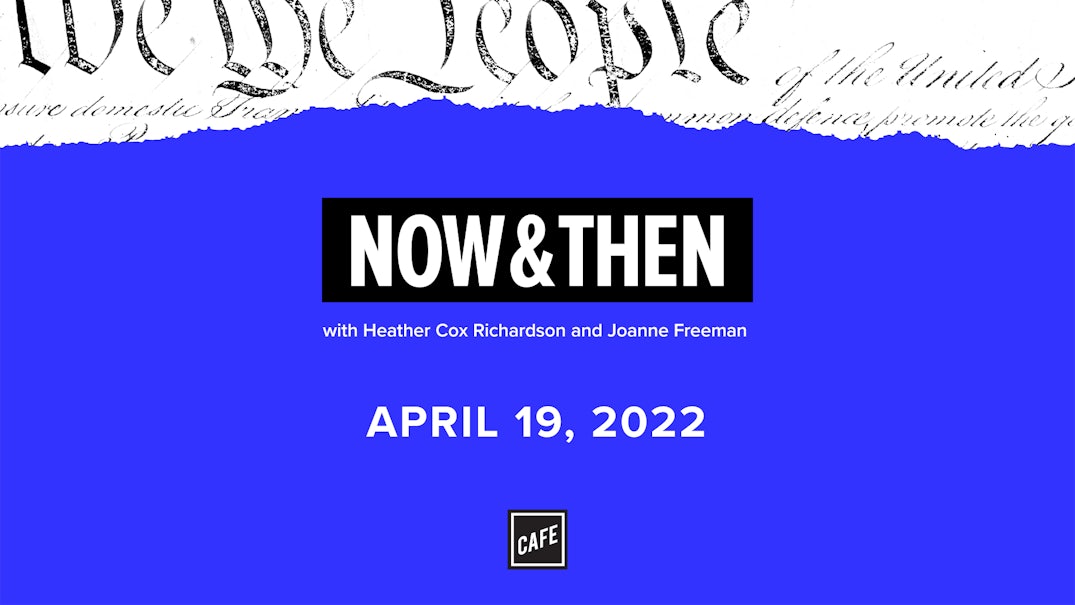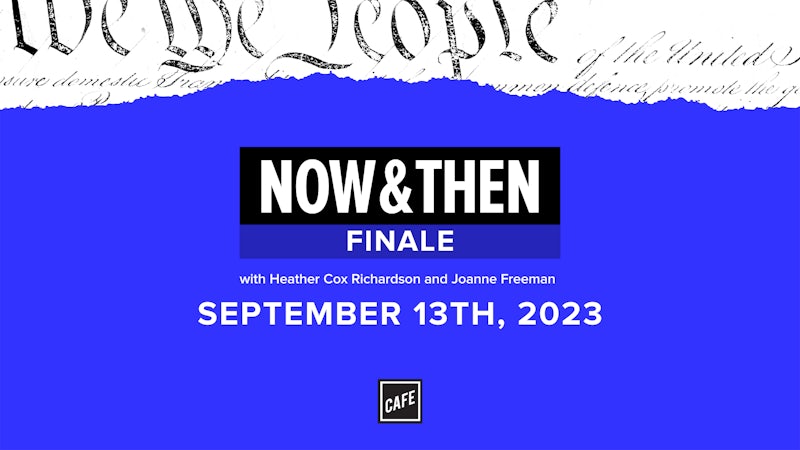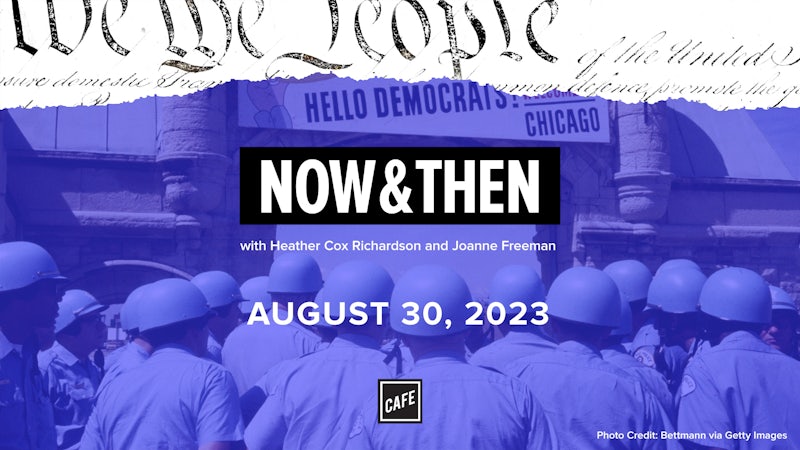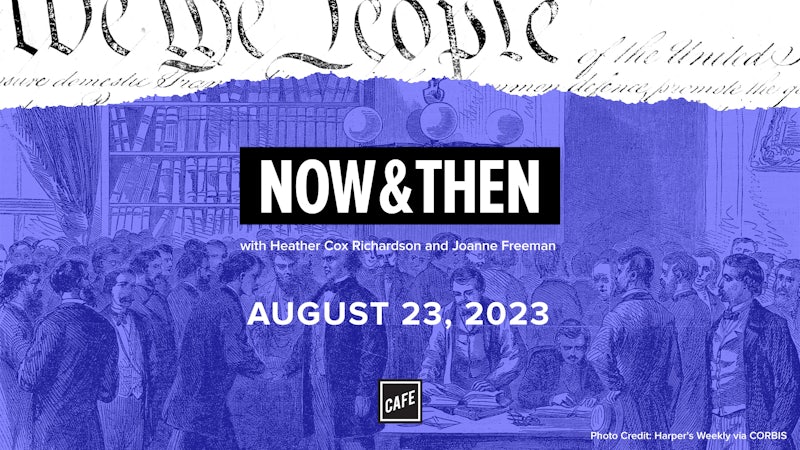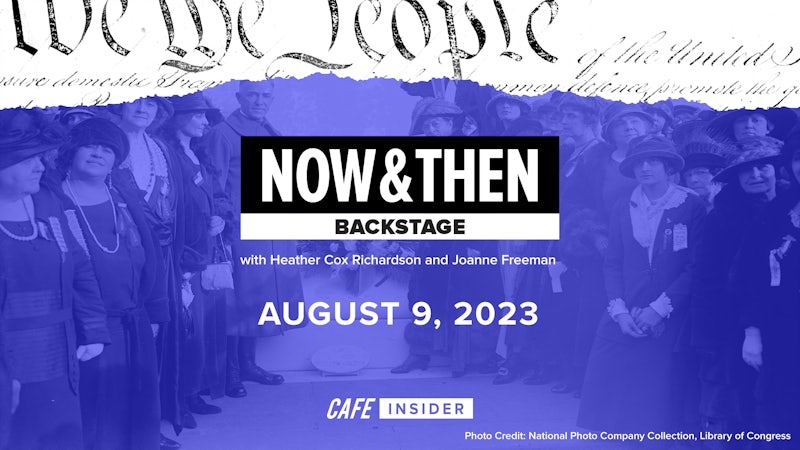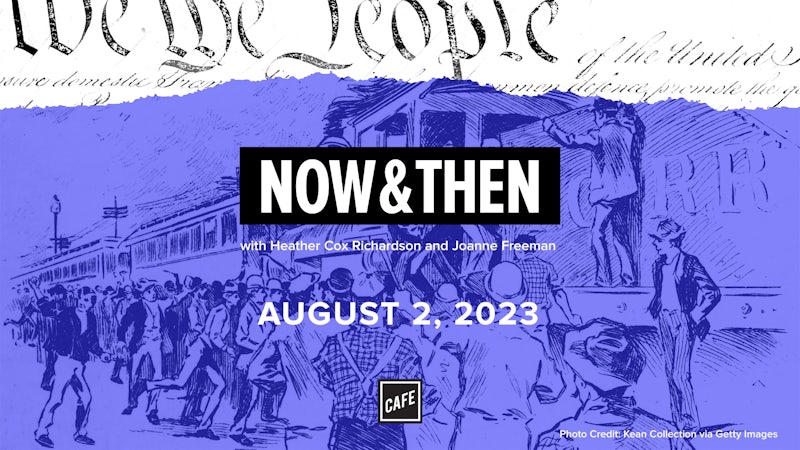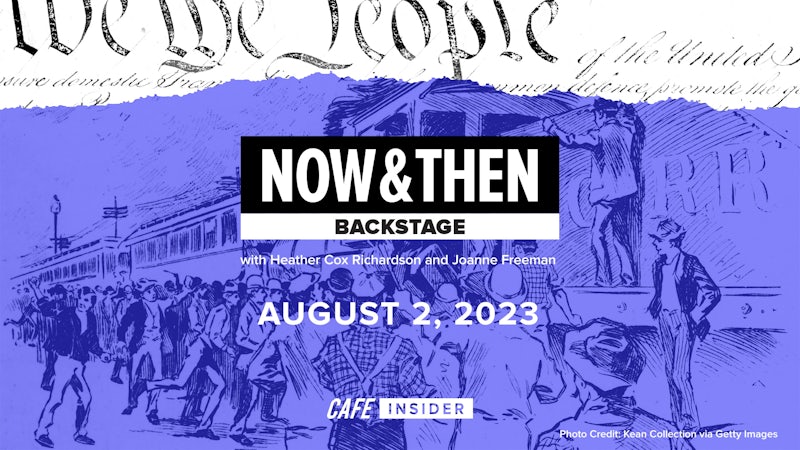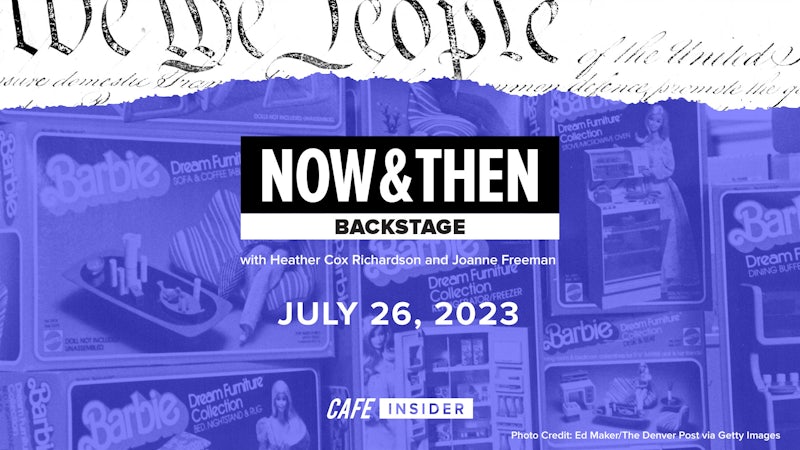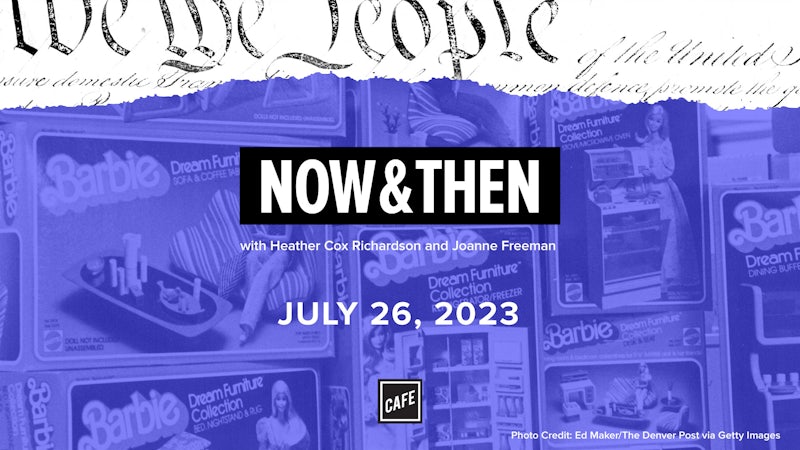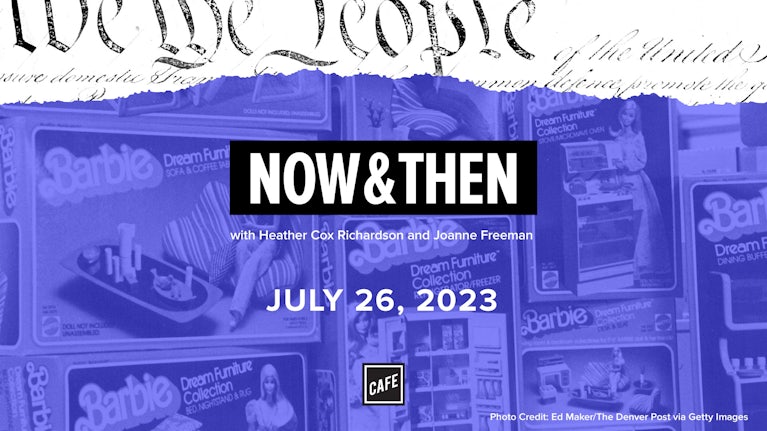Heather Cox Richardson :
From Cafe and the Vox Media Podcast Network, this is Now and Then. I’m Heather Cox Richardson .
Joanne Freeman:
And I’m Joanne Freeman. Today, we’re going to tackle a topic, which I’ll offer here in one word and then I’ll explain why that one word really doesn’t do it justice. So the one word I’ll throw out here is philanthropy which sounds sweeping and broad and maybe even a little bit boring. But what we’re really interested here and talking about is connecting people or organizations with money, with parts of society or people in society who can use or need that money. We’re trying to get a sense of who does the improving or connecting or funding of people in need or causes that need funding.
And there are a number of ways in which this has been intersecting in the news. One of them has to do with MacKenzie Scott who divorced Amazon founder and CEO Jeff Bezos in 2019 and set up her own corporation in Delaware called Lost Horse and she has been really giving out vast quantities of money. Most recently, she gave $276 million to Planned Parenthood, their largest single donation in history, 436 million to Habitat for Humanity, which is her largest known gift to date, over the last year, that $6.6 billion of grants that she’s given out, but she has been very explicit about saying that what she’s doing isn’t really about her, that she’s not putting herself front and center and we’ll be talking about some people in today’s episode who perhaps did put themselves front and center in this process, she isn’t.
So this is what she says, “People struggling against inequities deserve center stage in stories about change they are creating. This is equally, perhaps especially true when their work is funded by wealth. Any wealth is a product of a collective effort that included them. The social structures that inflate wealth present obstacles to them. And despite those obstacles, they are providing solutions that benefit us all. Putting large donors at the center of stories on social progress is a distortion of their role.” Really interesting point and a really interesting way of getting at some of what we want to touch on today which is that question, how do you connect money with society? How do you benefit or shape society for the better with money? Who’s doing it? Where’s the money coming from and who controls the outcome?
Heather Cox Richardson :
And ultimately, what does that say about our society? Who has the money? Who gets the money and how is that money used in such a way that it promotes the good of the community? And one of the things that I find really interesting is Scott’s emphasis on centering the people who are receiving the philanthropy, if you will, is so different than what most people think about when they’re crowdsourcing something, which is GoFundMe. And a lot of people are not aware that GoFundMe is in fact a for-profit company. And the argument behind that by the people who designed it was that being a for-profit company enabled them to hire the best people, and therefore, to pivot really quickly to different needs of the company.
Joanne Freeman:
Which I hadn’t thought about before. When we talked about this episode, and one of the things we mentioned was GoFundMe, it struck me because it seemed as though it was this weird example of people having no way to pay for a variety of different needs, healthcare needs or family needs or any kind of number of needs, and that here, there was the system that let people get in touch with other people to fund them. But as you just said, and I will confess I didn’t know that before we were thinking about this episode, it’s a for-profit organization. GoFundMe gives the idea that individuals helping individuals, it’s this widespread new movement that is a new kind of model.
If you look for example at GoFundMe campaigns that came out at the height of the pandemic from March to August of 2020, almost half received no donations at all and the typical charity drive collected just $65. So although it gives the impression that there’s this new safety net in which people help people, it’s not helping people as much as one might wish that it were.
Heather Cox Richardson :
And then there is my favorite topic, which I’d love to hear you talk at great length about Joanne, I did that just because the look on your face was like, “Darn it, here come the taxes.” The idea-
Joanne Freeman:
That was not the look on my face. That was not the look on my face. The look on my face was, “This is a Heather topic.”
Heather Cox Richardson :
Well, we’re going to define charity versus philanthropy and we’re going to talk about different ways in which people have handled both charity and philanthropy through time, but there is, of course, out there, the idea that people with extraordinary wealth should, I don’t know, pay taxes. And in fact, President Joe Biden at the end of March, on March 28th, unveiled his 2023 federal budget. And within that budget, there was the billionaire minimum income tax plan which would establish a 20% minimum tax rate on all American households that are worth more than $100 million. The way our tax laws are written, in fact, it’s possible as one knows if one follows are tax system for people of extreme wealth to pay actually very little in taxes. And so this would be a tax on all income including unrealized capital gains from increases in stock assets. That is, if your net worth goes up, you will be paying tax on that.
And the White House estimates that the tax would raise about $360 billion in new revenue over the next 10 years and it would cut the federal deficit an additional $1 trillion over the same period which would, of course, free up more money on both sides and that would enable the US government to put more money into social programs for example. Not everybody thinks that’s a great idea. One of the people who has been very critical of that idea is Elon Musk. Elon Musk is a serial entrepreneur and probably best known for Tesla and he has said, “Eventually they run out of other people’s money and then they come for you.”
Before Biden presented his 2023 budget, Musk actually began to give away some of his net worth, about 2.3% of his net worth, and that’s about 5.7 billion to charity, although it’s unclear whether or not he has given it away or if he has put it in what’s called a donor-advised fund which is essentially a holding cell for philanthropic donations where you can claim a tax deduction on the funds themselves. So it’s not entirely clear what he’s done and I just can never talk about his approach to this without mentioning the fact that Musk’s companies have received an extraordinary amount of large ask from the US government.
By 2015, Musk’s companies had received almost $5 billion in government support. So when he says, “Eventually they run out of other people’s money and then they come for you,” some of other people’s money went into the companies that have made him successful. So there’s a real question about where money comes from to support philanthropy and how it gets circulated through society.
Joanne Freeman:
Now before we start, it probably makes sense for us to just set the terms of our conversation here and talk about charity versus philanthropy. And they’re certainly connected and some people might even say charity can be a kind of philanthropy, but generally speaking, charity is seen as being a short-term solution to some kind of acute suffering or poverty, right? Like alms giving or donation giving or short-term housing. So it’s seen potentially as individual. Even if it’s broader than that, it’s seen as a temporary solution to a problem. Whereas philanthropy, generally speaking, is broader, is potentially more structured and is more focused on alleviating long-term poverty or inequality by addressing these kinds of structural inequities.
So there’s a difference between the two. And in a sense, although you’ll hear aspects of our conversation today, that sound as though they embrace charity, what we’re really interested in is the philanthropic organizational part, which is how does this happen, who does it and how does it end up shaping society. You’re laughing at me and I don’t even know why, Heather.
Heather Cox Richardson :
Well, I’m laughing just because when you use words like philanthropic organizational structures, to me, it doesn’t sound very interesting. And this is fundamentally about who has the money and how it gets used and the role of individuals in that. And when you think about the people we’re talking about, MacKenzie Scott, Elon Musk, can I tip our hand and say, Andrew Carnegie? They’re really fundamental figures in our society and say a lot about what American society should be like.
Joanne Freeman:
No, absolutely, which is why I started by saying it sounds boring when I say philanthropy. That’s why I said it, but I won’t take it personally that you just said, “Yeah, Joanne, you just put it in the most boring way possible.”
Heather Cox Richardson :
We need a better word than philanthropy because doesn’t that just sound like, I don’t know people sitting behind desks somewhere with a dusty light coming through the window and-
Joanne Freeman:
With the green shade on the lamp and … No, it totally does. And you’re absolutely right, that what we’re really talking about is people with a lot of money shaping society and how that happens and how it has changed over time and what does that tell us about today. So yes, way more interesting than the P word.
Heather Cox Richardson :
So let’s start with early America because this stuff is really cool.
Joanne Freeman:
Initially, particularly in colonial New England, you had a top-down way of dealing with the poor, but it was really community centered. So a town government would appoint someone to be what was basically called a warner, W-A-R-N-E-R, warner and their job would be warning out people who either coming into the town and couldn’t support themselves or at least finding, highlighting, pinpointing people who were poor and couldn’t support themselves in the town. Now, sometimes these people would have been told to leave town, that they couldn’t be supported. What’s important to realize with these warning outlaws and the process of warning out is it wasn’t just a matter of people in these New England town saying, “You’re poor. We don’t want anything to do with you. Beat it.” It was more a matter of trying to corral and deploy limited resources in a town.
So if people had, in a town, a certain amount of money they could give to the poor, these people who acted as warners, in a way, were just touching base with all the people who potentially would need that kind of assistance and determining or helping to determine what would happen to them.
Heather Cox Richardson :
You’re saying that it’s really about community providing for everyone. It’s not saying, “We’re going to have real gradations in society in which there’s really rich people and maybe we’ll help a few people at the bottom.” It’s saying, “We all need to have a minimum standard of living and we only have a certain amount of money, so we’re going to take care of our own, and if you’re an itinerant coming through here, keep moving because we ain’t got the support for you here.”
Joanne Freeman:
It’s a form of poor relief that’s community centered with some rough edges because there isn’t an endless supply of money. But it’s not a matter of drawing a strict line and throwing some people out. You’re right, it’s a community-minded way of dealing with money, resources and people who need them. And this was mostly in colonial New England. It wasn’t something that was practiced everywhere. There’s one particular person in Boston in the mid-18th century named Robert love, appropriately enough, and he was the warner at that point and that was his job, was to find people who were in need and determine who they were and what they were and where they belonged and did they belong and what kind of help did they need.
Now it’s interesting, because that kind of a model, it’s community minded, but it’s still top down because it’s a city, saying, “Here you, Mr. Robert Love, we’re asking you to take this position and figure this out. What’s interesting is, a little bit later in time when the Enlightenment really kicks in, now you have new ways of thinking about the world and society and morality and betterment and people begin thinking about things like charity and the P word, philanthropy, in a different way that it isn’t necessarily … I know I’m making you crawl under your desk again, Heather. I’m really sorry.
Heather Cox Richardson :
It’s the P word. I’m like, “Okay, I can work with the P word.”
Joanne Freeman:
Okay. That’s what it will be for the rest of this episode, the P word. But because of the Enlightenment and the sense that you can improve society through order and science and structure, people begin thinking more creatively and more broadly about how people with sources and money and finances can help benefit those who need it in society. And a really specific and actually well-known person who did this in a striking kind of a way is Benjamin Franklin. So given that most forms of charity and philanthropy in this time period were top down, Franklin in this Enlightenment period comes along and says, “Why does it have to be top down? Couldn’t people come together and pool their resources and create something for the community, do something for the community to benefit the community, that is the people in essence giving to themselves?”
So he has that kind of a method. He brings people together and they pool money to buy books to create a subscription library, for example. He brings people together, they pool money, they create a volunteer fire company. He finds a way to merge personal private money and public money to help create a hospital. So he, literally in this age of invention on a whole mini-level, scientific invention, social invention, political invention, Franklin is a person who’s applying that kind of creativity to philanthropy, to the ways in which you can get paid people together, apply their money and benefit society. And in his case, benefit the people living in that city.
Heather Cox Richardson :
We know the warning outlaws go on to be at the heart of a lot of our immigration restrictions, the idea that you shouldn’t be able to come here after 1882 if you can’t support yourself. But what I had not thought about until you were talking about this is that Franklin’s model is not at all unlike the model the settlement house workers used in the late 19th century, those women who go into tenement districts in Chicago, New York, Philadelphia and try to pool resources and they have childcare, they have education, they have sanitation. I’d never thought about that and I wonder … Yeah, isn’t that interesting? Again, we’re really talking about organizing society and I have always seen them as coming very much out of post-Civil War America, but in fact, that concept of working together to reestablish a communal sense in the country in the face of industrialization sounds a great deal like what he’s doing.
Joanne Freeman:
No, it’s true. And what’s interesting in the case that you’re talking about here, Heather, is we’re talking about women, right? And that’s a time period when women are increasingly being pushed out of politics which is becoming rough and tumble, party-driven, organized. And so many women are finding a public role for themselves doing this kind of work. So it’s striking that it’s a double whammy. On the one hand, they are coming together to use these kinds of methods to help society, and also, it’s a way for women to help shape society and play a public role.
Heather Cox Richardson :
But it gets better because, of course, they are credited and they articulate that the reason that they are organizing the settlement houses, like hall house for example, is that they’re really trying to file the hard edges off of industrialization. Because with industrialization, you get the real switch from needing charity for a few families to some systemic way to address the excesses of unrestrained moneymaking from the industrialists in the late 19th century. But at the same time that you get that industrialization and the extraordinary pots of money resting in a few robber barons, as they were known, you’ve also got that going on at the same time.
But when we think about philanthropy in this period, and the reason that I was shocked and took us down that rabbit hole, was because when people think about philanthropy in America, they think about the robber barons. They think about J.D. Rockefeller. They think about Andrew Carnegie. And there’s always, for me, this attempt to almost say, “Well, yeah, they abused their workers and people lost arms and they didn’t make any money. And the kids were working. And the little girls had to be on the streets and all that, but they gave us opera houses.” And that, in a way, almost seems to be a justification of the economic stance because of the philanthropy that they defined at the time.
Joanne Freeman:
So here’s an alternate model in a way, here’s a different way of doing it that makes what you’re talking about stand out even more.
Heather Cox Richardson :
But the women who were running the hall house, for example, didn’t have that kind of money because they were pooling it from within the community.
Joanne Freeman:
And also the other thing that’s happening in that period which wrecks the community model and will continue to make it harder to do that for the rest of this episode, as well as in American history is, with the rise of industry, you have the rise of cities. And that’s just a whole different ballgame when it comes to people, community, people drifting, coming in and out. The ability to be anonymous in a city, that creates all kinds of new challenges too. For more Cafe history content, check out Time Machine, a weekly column by our editorial producer, David Kurlander, inspired by each Now and Then episode.
Heather Cox Richardson :
You can receive the Time Machine articles through the free Cafe brief email. Sign up at cafe.com/brief. So in contrast to the idea of having philanthropy based in a community model, you have the rise of people like Andrew Carnegie, who comes from that sort of a model, but he used his business to try to benefit mankind as he would have said. And he’s an interesting duck himself. He was born in Scotland in 1835. He comes to America when he’s 13. He’s the son of a loom maker and he begins to work as a bobbin boy actually. And quickly, it’s very clear he’s very bright. He moves up into the office work and he becomes a messenger boy. And he talks, when he’s young, about how important it is to him. He feels like he has gone to heaven to go to a place where there’s actually windows, so he doesn’t have to be stuck at the looms any longer.
And he very quickly becomes first involved in offices and then he begins to work in railroads and quickly amasses a fortune first in railroads and then in steel when he recognizes during the Civil War that it’s very difficult to run railroads over wooden bridges because the sparks from the railroad engines catches bridges on fire. He figures that you got to have bridges made of, at the time, iron. He’s going to be able to use steel after the 1870s. And he founds Carnegie Steel once the Bessemer steel process really gets established in America in the early 1870s. In Pittsburgh, he starts a foundry that absolutely takes off. He’s one of the first people to recognize how important steel is going to be to the construction of America after the Bessemer process.
But as he begins to amass a fortune in the 1880s, he begins to speak out for what he considers a scientific and a very rigorous form of philanthropy of giving. And it’s interesting because he focuses on his past. He comes to America at a time when it is still possible for that immigrant boy who starts as a bobbin boy in the looms to work his way up to a man of fortune. And of course, we know that that was possible only for a very brief period of time, but he keeps trying to say, “Well, yes, you can still do this.” So for example, he’s going to invest a lot of money in libraries and in all sorts of ways in which working kids can better themselves and he doesn’t seem to understand that when you’re working seven days a week, 80 hours a week, living in squalor, no education, terrible food, pollution, it’s not really possible to do that. He clings to that old idea.
Right after the election of 1888, which is one of our elections where the elected president doesn’t actually win the popular vote and gets put in during the Electoral College, there’s a real sense that business has stolen that election in ’88. So in 1889, Carnegie writes this article called Wealth in The North American Review and this becomes known as the Gospel of Wealth. And it’s a fascinating look at what he believes America should be because he makes the argument that it’s actually a very good thing that there were a few really rich people in America and a lot of really poor people in America.
So one of the things that he says is individualism, private property, the law of accumulation of wealth and the law of competition are the highest forms of human society. And the reason for that, he says, is because if you let poor people actually have more money, they’re going to fritter it away in stuff like food and shelter and the society as a whole will not move forward. Whereas if you let it concentrate in the hands of a few people like him, they’re going to use that money to establish, well, libraries and schools and opera houses and art collections and things that are highly capitalized that lots and lots and lots of people can enjoy.
And there’s Carnegie, of course, but then there’s also people like Henry Frick, who’s why we have the Frick Museum in New York City. There’s all sorts of people using this idea that they need to concentrate wealth.
Joanne Freeman:
All of those kinds of things that you just named, Heather, all of these cultural creations, opera houses and such, are not things that would rise in and of themselves, right? So this is a man of business who can see and has been, himself, creating and shifting and crushing and forming businesses. And he is saying, just as you said, “Well, if you’re really wealthy, you can give out your money to create these cultural institutions that otherwise wouldn’t exist at all. So isn’t it wonderful that the wealthy have the resources to be able to create these things? Because without us, they might not be there at all.”
Heather Cox Richardson :
It’s one of the things I challenge my students on actually, is I show them a lot of the images from the Frick which is just a spectacular collection. And I say, “Was he right? Was this a good thing to give us all these years later?” I have a fairly strong set of opinions about that, but there is the reality that in the late 19th century, people like Carnegie and other people who were truly horrific to their workers, have given us lasting cultural institutions, universities, JD Rockefeller funded the University of Chicago, for example, schools and libraries all over the country. At the end of the day, Carnegie actually created about 1,400 libraries in America. He gave me about $41 million to do that. And the same in Britain and Ireland, he gave another 15 million there.
So the trick though to Carnegie was that while he said this was a great idea for wealth to move upwards so that people could create a capitol bank as it were to create all these institutions, the flip side of that was that he thought that rich people had to give their fortunes away. That was part of it. If they were going to stack the laws as they were stacked at the time to move all the money upward, part of the social contract was for those people who got all that money, then to give it back to the people. And one of the things about the Gospel of Wealth is he’s really rooting on his fellow industrialists who are not giving their money away and who are instead throwing these incredibly lavish parties.
So he insists that you have to give all your money away, for the rich people. He talks about how the man who dies rich dies disgraced. And yet, while he gave his money away, about $350 million of it and created, as I say, libraries and universities and the Carnegie Corporation, he gave an endowment of $120 million, and as trustees, we’re supposed to use the funds in promoting the increase in diffusion of knowledge and understanding amongst the people.
Joanne Freeman:
And it’s that public conversation, the sweeping conversation that certainly he wants to be known for, but the other part of the conversation, the more personal conversation is built in to the capitalism of philanthropy as well.
Heather Cox Richardson :
Well, and Theodore Roosevelt didn’t like Carnegie. They had a number of differences, but one of the interesting things about that difference is that he believes that Carnegie is obsessed with money making and that his focus on philanthropy is in part because he’s trying to justify how much he focuses on making money. And Roosevelt, for his part, believes in developing a stronger federal government that will enable the government itself to provide the sorts of services, not necessarily the libraries and the opera houses that Carnegie focuses on, but the sort of social good community services that currently in his era were being provided to the degree they were by people like Carnegie.
So he recognizes that idea that the businessmen should run everything sounds really highfalutin and lovely when it comes from Andrew Carnegie’s pen, but the reality is that the society that they’re creating is so incredibly top heavy for most Americans who are never going to see the inside of Carnegie Hall. It’s a lovely thought, but that really we need to have a different kind of philanthropy.
Joanne Freeman:
And I like the way that Roosevelt puts it because it’s pretty blunt and straightforward. He says, “I’ve tried hard to like Carnegie, but it’s pretty difficult. There is no type of man for whom I feel a more contemptuous abhorrence,” so clearly, he’s having difficulty liking him, “than for the one who makes a god of mere money making. All the suffering from Spanish War comes far short of the suffering, preventable and non-preventable, among the operators of the Carnegie Steel Works and among the small investors during the time that Carnegie was making his fortune. Unrighteous war is a hideous evil, but I am not at all sure that it is worse evil than business unrighteousness.”
Heather Cox Richardson :
It is worth pointing out that Roosevelt knew what he was talking about. He investigated the situation in the New York factories, but in Carnegie’s factories in Pittsburgh, employees worked 12 hours a day, six days a week. They got one day off a year, that was July 4th, and most workers had to retire by 40. There was no retirement plan. There was no workers’ compensation for any kind of an injury. And there was no safety masks, no OSHA, nobody who would protect those workers at all. And they were not going to the opera. And the idea that they were going to go to the library after a 12-hour day on the shop floor and learn enough to rise was just pure fantasy on Carnegie’s part.
Joanne Freeman:
It’s pure fantasy and it’s the kind of fantasy you can have when you’re as high up as he is and as disconnected as he is from the reality of what’s happening in other parts of society.
Heather Cox Richardson :
There’s no law that says you can’t both pay your workers well and use the money that you get to endow maybe fewer libraries. I’m a huge fan of libraries. And if you think about the stuff you and I do, Joanne, there are philanthropists at work right now in America on a much smaller scale than MacKenzie Scott, for example, but they do amazing stuff.
Joanne Freeman:
That can even have a bigger impact in a way, because where we started, it’s a community basis. Different kinds of philanthropists can be creating things on a smaller scale that could have an enormous impact on people precisely because they are at something like Carnegie Hall in New York City. They’re a local library or a local historical society or a local organization of some kind that can have a huge impact for the people who live there.
Heather Cox Richardson :
And their workers have enough time off and enough pay to actually take a Saturday off and go to historical society, for example. I felt like I was being a little bit negative about all this, but to me, it doesn’t seem like a jumbo shrimp to have somebody both build a library and pay a living wage. So we have the community model, we have the business model and then we have Teddy Roosevelt saying, “This is stupid. We need to use the federal government in such a way,” by the way, that was my paraphrase of my friend, Theodore, “We need to use the federal government in such a way that it takes care of these issues.” And that really takes off of course after World War II.
Joanne Freeman:
Now this brings us, just as you said, Heather to another model, which is LBJ’s Great Society, his view of society and his view of the ways in which government should be filling some of the roles that we’ve been talking about in the other models of the P word in this episode. Now, most of the Great Society’s achievements came during the 89th Congress which lasted from January 1965 to January 1967. And President Johnson pushed Congress to pass nearly 200 new laws, including things like civil rights protections, Medicare and Medicaid, food stamps, urban renewal, the first broad federal investment in elementary and high school education, Head Start, college aid, consumer safety and environmental regulation, so really a whole slew of different kinds of regulations aiming in one way or another at civil good, social good.
Several of Johnson’s new programs funneled government money to nonprofit organizations and other philanthropic groups that had not in the past received that kind of substantial federal funding. So for example, the 1964 Economic Opportunity Act created the community action program, which distributed federal funds to local community action agencies which were often collections of private nonprofit organizations, so that by the end of 1966, the federal government had made more than 900 grants for community action programs in some 1000 counties. So it’s the government stepping in and acting on that community level to fund things happening on that community level.
Within a few years, federal spending for social services jumped from 281 million in 1967 to 740 million in 1971 to 1.69 billion in 1972. And this spike was also seen in nonprofits. For agencies receiving community action agency funds, the average grant accounted for 34.1% of their budget. So you’re seeing massive change with this kind of sweeping new way of having the government step in to fund these organizations that in many ways are collections of local organizations.
Heather Cox Richardson :
And that are the same sort of philanthropic things, not always, but often the same sort of philanthropic things that 75 years before would have been funded by somebody like Rockefeller or Henry Frick. And I find that fascinating on two levels, the first of which is that what that means is that a federal panel is deciding what gets funded. And that ain’t going to fly in individual states, especially southern states and especially religious states. And those two things, of course, overlap pretty significantly.
Joanne Freeman:
Another thing that’s happening with this new model of having the government fund these sorts of efforts locally has to do with civil rights. So for example, McGeorge Bundy, who heads the Ford Foundation, is a big supporter of this idea. As the Ford Foundation president, he orchestrates, in 1967 and 1968, a number of really high-profile collaborations with civil rights groups including a voter registration project in Cleveland and an early experiment with school decentralization, basically bussing in Brooklyn’s Bedford-Stuyvesant. So not only are you having these local community efforts to benefit people, but civil rights as well, national institution federal money, stepping in to change society, to shape society, to better it in that way on this level as well.
Heather Cox Richardson :
And that creates this enormous backlash because there is this sense that federal bureaucracy is using tax dollars to impose a certain way of life on people who might not want it and civil rights is the major issue for those people. But the one that always interests me is art. And what interests me about it is that Nixon even starts to increase the amount of money that goes to these different programs, but he starts to divide it by state, so people can do fund things within their own states and not have to deal with a national standard. But from the beginning, people begin to complain that the federal government is putting money into things they don’t see as art. And that doesn’t necessarily mean they’re obscene or deal with racial issues or any number of things, but it might simply be, “Well, my kid could do that. Why did we put that kind of money into that?”
What interests me about that is, again, Carnegie and Frick bought painting, some of which are brilliant and some of which are not. And yet, again, I guess the idea was somehow it was their money, although, of course, they’re getting all that money because of the way they’re treating their workers. But what fascinates me about the backlash against the idea of this governmental assumption of philanthropy is that in the same period that people are complaining about this expansion of government philanthropy, the CIA is actually funding art as well. And that doesn’t come to light for a while, but the CIA is actually funding really avant garde artists because they’re trying to demonstrate during the Cold War, that America is a place of free ideas and freedom of expression and you can be a Jackson Pollock, for example, who had CIA money or Mark Rothko or Robert Motherwell and that America and democracy supports these sorts of people, even though the CIA is actually funding them.
And there isn’t a backlash against that, but there is a backlash against the idea of the government funding those things on a civilian level. And I just don’t even really know how to think about that, but it’s okay for the CIA to fund that, but it’s not okay for the National Endowment for the Humanities to fund really avant garde work.
Joanne Freeman:
It’s interesting because the CIA doing it frames it, and the way that you put it, frames it as a political strategic move which in a sense could induce a lot of people to step back and say, “Well, whatever. I don’t know about that art. I don’t love the art, but it’s the CIA,” whereas the NEA or other organizations funding art, even the same art, that’s going to seem, in the same way that we’ve talked about the humanities today, right? “Is that really necessary? What does it do? How do we feel about it? Is that really important to society?” It feels like that becomes vulnerable to a kind of criticism that maybe, oddly enough, the CIA funding isn’t.
Heather Cox Richardson :
And in this period, in the ’60s, when there is focus on the voices of previously marginalized people, the idea that tax money is explicitly going to civil rights, for example, or to those sorts of different programs and it has gone to traditionally for philanthropies that were controlled by people like JD Rockefeller or Andrew Carnegie creates a culture war, creates the idea, “That’s not my America. Why are my tax dollars going to fund civil rights?” for example, which brings up the idea of who is responsible once again for the creation of a society in which everybody is enjoying at least a minimum standard of wellbeing that includes not only their economic support, but also their visibility.
Joanne Freeman:
And it brings up two things besides that, that kind of question about the government stepping in and funding these sorts of things. It brings up the issue of, on the one hand, trust, who do you trust to be spending that kind of money and I think it’s one thing if these Carnegies of the world, the Fricks of the world using their own money in a sense are outside of this question, but we live in a moment when, “What do you trust as far as national institutions go, as far as centers of government go?” right? People are distrustful of so much right now when it comes to organized anything. If you’re looking at this kind of organized expenditure of money and it’s coming from the government, just as you said, with culture wars, it gets linked up into that question as well.
And it also gets bound up with a bigger question, which really, in a sense, is smacked at the center of where we are as a nation right now and that is, “Who is the we that is being helped, created and shaped by these efforts? What is the we?” right? Because if you’re helping society in any way, you’re assuming that there is a we that that effort is part of. And if you’re polarized as we are right now and you have people really fundamentally not agreeing on what America is to a pretty profound degree, what do you do with these sorts of efforts if they can happen in one way particularly from government with government money, which means it’s coming from people’s contributions, people’s taxes, it’s not just the government? What do you do? How does that happen without sort of automatically drawing a backlash from people who claim in highly polarized times, “That’s not my America. Don’t use my money for that. That’s not we That’s not who we are”?
All of these philanthropic efforts are about, in one way or another, supporting a we. That’s a way of understanding civil society.












